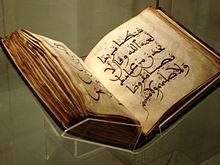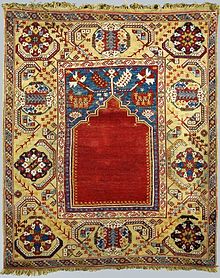User:Ksalivon/sandbox
Religious Symbols and Artifacts of the World
[edit]It has been the custom of many religions around the world to incorporate different items in their religious worship. These items and symbols are often used to encapsulate certain values of the culture by telling a story without words. The shape, color, and design of these religious artifacts continue to be used as a way of representing that branch of religious worship and to pass the traditions on throughout generations. Below are descriptions of some of the more popular symbols of different religions.
TAOISM
[edit]Philosophical and religious practice of Chinese origin
The 8 immortals (Baxian)
[edit]
-
These Crazy Guys and Gal
These early practitioners of Taoism are used as an archetype of the immortal teacher. These legendary figures are used to tell stories of inspiration and devotion to ‘the way’ through their often magical experiences. Their names have changed throughout the different dynasties of China and their tales continue to be built upon in artwork appearing throughout the centuries. Their stories usually show their journey from mortals of all walks of life, both man and woman, beggar and noble, young and old, to the attainment of immortality.
Each immortal has their own unique instrument: Clapper, Fan,
Crutch, Flute, Sword, Bottle, Whisk, and Flower Basket. These are also known as
the ‘eight treasures’ as each holds a symbolic significance in the Taoist
world. These items are often used independently to represent one of the
immortal teachers.
The 8 TriGrams (Bagua)
[edit]
-
These Awesome Lines
Naturally occurring processes that represent movement and change and are usually associated with a family member, animal, season, direction or personality type. It is organized in two different arrangements, Early Heaven and Later Heaven.
In the beginning there was the Wuji
or ‘great void’. It is the empty and undefinable that twists and becomes the
Tai Ji symbol which represents the light and dark
sides. Each of those sides become a symbol on their own known as Yin, a solid
line ____, and Yang __ __ a broken line. These lines are combined into 3 line blocks
known as Trigrams to create the Bagua.
These Trigrams are then put into special arrangements to
represent the passage of time and its cyclical nature. It can be used as an
oracle to answer questions in a riddle like fashion that requires
interpretation based on the stacking of the Yin and Yang pieces of the trigram.
It is also consulted as a way to measure balance and flow and is often used for
Fen Shui.
SIKHISM
[edit]Sikhism was developed in 16th and 17th century India by the Guru Nanak and is the fifth largest organized religion in the world, despite only being in existence for approximately 500 years.
Khanda
[edit]
-
The Emblem
One of the most recognizable and universal symbols of the Sikh faith is the Khanda. It is used to symbolize the four pillars of Sikh belief and consists of four symbolic weapons. The double edge sword, or Khanda, representing the knowledge of divinity and creative powers of God. The metal ring, or Chakkar, represents the unity of God; the continuous cycle of life and death. As well as, two crossed daggers, or Kirpans, that represent the spiritual and temporal powers in balance. The Khanda can be found on the Sikh flag as well as on pins that adorn the men’s turbans.
Ik Onkar
[edit]
-
One with Everything
Another important symbol of Sikhism is Ik Onkar which means “One with Everything” and appears on all Sikh scriptures. The symbol has two components that translate as follows: Ik stands for Gurmukhi number “One”; Onkar stands for “Brahma or Creator”. Ik Onkar communicates the cornerstone of the Sikh religion, the idea of the unity of God. The creator and creation are of one entity, inseparable. Sikhism urges follows to realize that we are all bound to the creator and each other in such a way, that we are all inseparable.
EPISCOPALIAN
[edit]Christian denomination of the Anglican Tradition.
The Liturgical Season and Colors
[edit]
-
Liturgical Colors
The calendar is divided into seasons that celebrate particular periods of the life of Jesus and the Church. The two main cycles of feasts and holy days are dependent on the fixed date of Christmas and on the movable date of Easter. The liturgical year begins with Advent. The Liturgical Seasons are Advent, Christmas, Ordinary Time (Time after Epiphany), Lent, Easter, Pentecost and Ordinary Time (Time after Pentecost).
The use of colors to differentiate
liturgical seasons became a common practice in the Western church in about the
fourth century. At first, usages varied considerably but by the 12th century
Pope Innocent III systematized the use of five colors: Violet, White, Black,
Red and Green. Colors can be used in altar and pulpit decorations, vestments,
banners and tapestries.
Each season is represented by a
color:
·
Advent - Violet or Blue
·
Christmas - White
·
Ordinary Time - Green
·
Lent - Violet or Blue
·
Easter – White
·
Pentecost – Red
The colors express emotions and
ideas that are associated with each of the seasons of the liturgical year. Violet is the ancient royal color and
therefore a symbol of the sovereignty of Christ. Violet is also associated with repentance
from sin. White and Gold symbolize the
brightness of day. Black is the
traditional color of mourning in some cultures. Red evokes the color of blood, and therefore is the color of martyrs and
of Christ’s death on the Cross. Red also
symbolizes fire, and therefore is the color of the Holy Spirit. Green is the color of growth.
The Trinity
[edit]
-
The Trinity Knot
The historic symbol of the Trinity that
is seen on our letterhead uses the symbol of the Father (Creator God) in the
form of a hand descending (Top left hand corner). The symbol of the Son (Holy
Redeemer) is shown to the right as a Shepherd carrying a lamb that is
referenced to Jesus Christ who has redeemed us and the symbol of the Spirit is
seen directly below in the form of a dove (Life Giving Spirit). Each symbol is
connected with the Latin words 'Non est," (That
which is not) indicating that the Father 'is not' the Son and the Spirit 'is
not' the Father nor the Son and vice versa. The three symbols are connected by
the Latin word 'Est' (That which is), and these point to the center triangular
figure with the Latin word 'Eus' (To have the nature
of or resemblance of), which indicates that the three distinct persons of the
Trinity have and share in the same nature of divinity.
Traditionally, we have referred to the Trinity as Father, Son, and Holy Spirit.
Today however, a contemporary understanding of the unique character of each is
better stated as God Creator, Redeemer, and Life Giving/Holy Spirit. In this
way each person shows forth a unique relationship and role in the godhead while
sharing in a like divinity.
MUSLIM
[edit]The Quran
[edit]
-
The Islamic Holy Book
This is a holy book used for guidance through all aspects of life. According to The Origin of Quran “…the Quran is the only revealed book that exists in the precise form and content in which it was originally revealed.” Muhammad did not know how to read or write so when the Quran was revealed he called upon his scribes to keep the text how it was originally founded.
Prayer Rugs
[edit]
-
Man In Prayer
Prayer rugs are used to kneel during prayer to ensure the cleanliness of their prayer time. They are not required to have a prayer rug but they have become a part of tradition. Most rugs are a meter in length and are made of silk and cotton. While the rug is in use it is known that the Mirab must point towards Mecca. The decorations on the prayer rugs are used to recall memory and help bring one closer to worship.
EGYPTIAN
[edit]The Eye of Horus (Wad jet)
[edit]
-
The Magic Eye of Egypt
The eye of Horus was a powerful symbol of protection in ancient Egypt. It went by many names. It was known as the all Seeing Eye, the Ujat meaning the whole one and the Wad jet. The eye represents the eye of the sky god Horus. As the story goes, Horus was fighting with another Egyptian god named Set. In the battle Horus lost one of his eyes. Throth, another Egyptian god, restored Horus’ eye and renamed it Wad jet (meaning whole). When he restored the eye it represented the moon which appeared every lunar month. It is also referenced as the eye of Ra. The eye of Ra is a powerful and destructive force linked with the fierce heat of the sun. In this story Ra was angry at mankind because they stopped believing in him and joking about him. He sent his daughter down and she started killing mankind. This is why it is also known as the daughter of Ra. When Ra thought mankind had enough he tried to get his daughter to come back, but she wouldn’t, she was blood thirsty. He stained the earth with red wine which looked like blood and she got drunk and he bought her back home. The Egyptians used the eye of Horus in several ways. Sailors painted the symbol on the side of ships for protection. People wore it as jewelry for protection. They divided into six parts and each symbol represented a fractional measurement (¼, 1/16, 1/8, 1/32). It also represented the six senses.
The Ankh
[edit]
-
Golden Ankh
The Ankh is the most famous and widely used symbol in ancient Egypt. It appears on hieroglyphic text or iconographic art all over ancient Egypt. There is an ongoing debate about this symbol. Some intellects believe that the symbol represents a sandal strap called the ‘nkh. Others suggest that it was a totem that represented the male and female reproductive parts. Some say it was the sun on a horizon and the sun’s path lies before it and was used as a ceremonial girdle. Most of them agree that is an ancient hieroglyph which represents ‘nh (life or breath of life). You can go around all parts of Egypt and see the ankh on display. They have pictures of gods depicted bearing an ankh to represent vivacity and immortality. Occasionally the god is seen extending an ankh to the pharaoh indicating both the gift of life and the purification of the subject. The ankh is a directly associated with life and death in Egyptian culture. In more modern times the Christian Coptic Church adopted the ankh as a form of the cross. It was known as the Crux Ansata (cross with handles). In the 1990s hip hop artists made it popular to where an ankh as it promoted the afro-centric movement and it also was known as “the key of life”.
JUDAISIM
[edit]
Material objects are apart of almost every religion. Each religion has a purpose or cause for each of these items. In the Judaist religion the word for amulet is, kame’a, meaning, “to bind”. The Hebrews has a belief that by “binding” oneself with one of these amulets to bring good luck. Most of the earlier “talisman” were actually in written form on a piece of paper. People would have these different kame’a for different occasions. The Hebrew believed that a kame’a in written form was much more specific thus granting it more power since it was for a particular reason. This was the most prevalent and desired form of making, giving, and/or receiving a kame’a because it was more personalized, enhancing its magic.
CATHOLICISM
[edit]
Saint Benedict medal is an amulet that is used in the Catholic religion to protect against evil. The medal is one of the oldest and most honored medals used by Catholics and due to the belief in its power against evil is also known as the "devil chasing medal" St. Benedict medal can be worn as a form of jewelry or keychain, it can even be placed in your purse or pocket for safe keeping or displayed in your home. An amulet is a lifeless object that is carried on one's person that is used to protect or bring good fortune. Amulets can be any object that you believe protects you. Some people use different stones or gems or other saints as their form of an amulet.
Sources:
[edit]
Chan Wing-tsit. A Source Book
in Chinese Philosophy (Princeton, 1963). ISBN 0-691-01964-9.
LaFargue, Michael. Tao and
Method: A Reasoned Approach to the Tao Te Ching (SUNY Press. 1994) ISBN 0-7914-1601-1
[[1]]
ST ALBAN'S EPISCOPAL CHURCH in
Bovina, Mississippi: [[2]].htm









